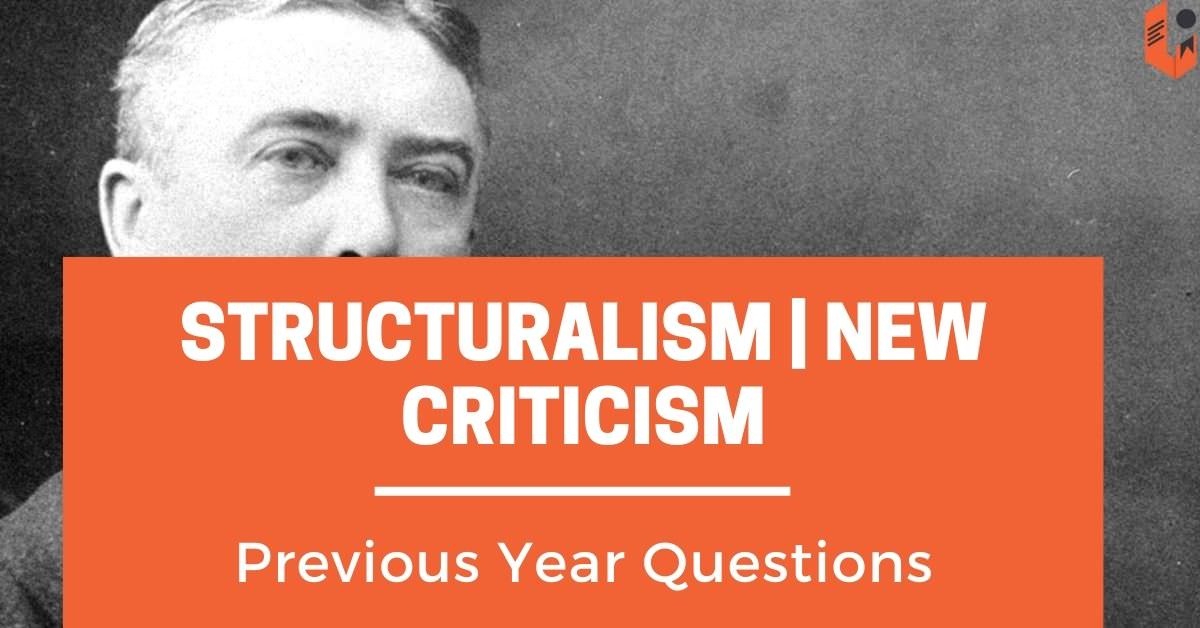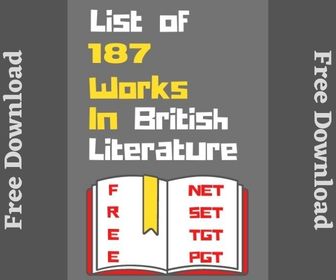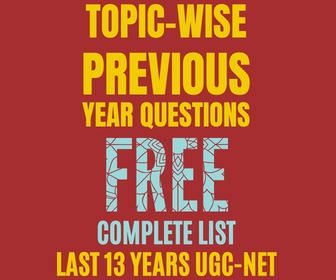UPDATE: Now, you can get these 3000+ questions in booklet/hardcopy format. Click here to know more.
“How can what an Englishman believes be heresy? It is a contradiction in terms.” This means
1. An Englishman does not know what heresy is.
2. An Englishman has no beliefs.
3. And, therefore, there is no question of his heresy.
4. And, therefore, there cannot be any question of his acting his beliefs.
(A) 1 and 4 are correct
(B) 2 and 1 are correct
(C) 1 and 3 are correct
(D) 2 and 4 are correct
Ans: (C)
Understanding Poetry used to be a classic textbook that encapsulates the principles of …
(A) New Historicism
(B) New Aristotelianism
(C) New Criticism
(D) The New Left
Ans: (C)
In literary studies structuralism promotes
(A) new interpretations of literary works.
(B) the view that literature is one signifying practice among others.
(C) a systematic account of literary archetypes.
(D) unstable structures of systems of signification.
Ans: (B)
New Criticism considers text as a :
(A) Cultural construct
(B) Historical construct
(C) Linguistic construct
(D) Autotelic
Ans: (D)
William Empson’s Seven Types of Ambiguity is
(A) A structuralist study of narrative
(B) A piece of psychoanalytic criticism
(C) A study of the media
(D) An analysis of poetic ambivalence
Ans: (D)
Which of the following is not a critical study by William Empson ?
(A) Seven Types of Ambiguity
(B) The Dyer’s Hand
(C) Milton’s God
(D) Some Versions of the Pastoral
Ans: (B)
Who among the following is a well-known Neo-Aristotelian critic ?
(A) R.P. Blackmur
(B) John Crowe Ranson
(C) R.S. Crane
(D) Lionel Trilling
Ans: (C)
Who among the following critics discerned in the Shelleyan Lyric the signs of adolescence?
(A) F.R. Leavis
(B) T.S. Eliot
(C) Cleanth Brooks
(D) I.A. Richards
Ans: (B)
Which of the following best summarises the structural approach to literature?
(A) Meaning is inherent in the word itself.
(B) A language’s history explains how it works.
(C) Meaning is generated through relationships in a system of signs.
(D) Binary oppositions are to be avoided at all costs.
Ans: (C)
Two among the following critical journals became strongly associated with New Criticism.
(a) Partisan Review
(b) Southern Review
(c) Kenyon Review
(d) Hudson Review
The right combination according to the code is :
(A) (a) and (b)
(B) (a) and (d)
(C) (b) arid (c)
(D) (c) and (d)
Ans: (C)
Identify the New Critic who served as the cultural attaché at the American Embassy in London from 1964 to 1966 :
(A) John Crowe Ransom
(B) Cleanth Brooks
(C) Allen Tate
(D) Robert Penn Warren
Ans: (B)
Semiotics, the general science of signs, traces its lineage to
I. Edmund Husserl
II. Charles Sanders Pierce
III. Ferdinand de Saussure
IV. Claude Levi-Strauss
The right combination according to the code is
(A) II and III
(B) I and III
(C) III and IV
(D) II and IV
Ans: (A)
What is practical criticism?
(A) The close analysis of literary texts in such a way as to bring out their political meaning.
(B) A movement which wished to make literary criticism more relevant.
(C) The close analysis of poems without taking account of any external information.
(D) The study of ambiguity.
Ans: (C)
One of the most highly revered, scholarly, and passionate interpreters of English and world literatures, he was appointed the Lord Northcliffe Professor of Modern English Literature at University College, London in 1967, and later as King Edward VII Professor of English Literature at Cambridge in 1974, an appointment made by the Crown at the suggestion of the Prime Minister of the United Kingdom. He was knighted by Queen Elizabeth in 1991. Entitled to designate himself as “Sir,” he never did, but wrote and autobiography entitled Not Entitled in 1995. The epigraph to this book came from Coriolanus : “He was a kind of nothing, titleless.”
Who among the following is this writer/critic ?
(A) F. R. Leavis
(B) I. A. Richards
(C) Frank Kermode
(D) David Lodge
Ans: (C)
The title, The New Criticism, published in 1941, was written by
(A) Cleanth Brooks
(B) John Crowe Ransom
(C) Robert Penn Warren
(D) Allan Tate
Ans: (B)
The term ‘Intentional Fallacy’ is first used by
(A) William Empson
(B) Northrop Frye
(C) Wellek and Warren
(D) Wimsatt and Beardsley
Ans: (D)
The term ‘Practical Criticism’ is coined by
(A) William Empson
(B) W. K. Wimsatt, Jr.
(C) I.A. Richards
(D) F. R. Leavis
Ans: (C)
“Heteroglossia” refers to
(A) the multiple readings of a text.
(B) the juxtaposition of multiple voices in a text.
(C) the comments on the margins of a text.
(D) the gloss or commentary relating to a text.
Ans: (B)
Match the following:
(Schools/Concept of Criticism)
I. Formalism
II. New Critics
III. Psychological Theory of the Value of Literature
IV. Literary art as archetypal image
(Critics)
1. John Crow Ransom
2. The Jungians
3. Victor Shklovsky
4. I.A. Richards
The correct combination according to the code is:
I II III IV
(A) 3 1 4 2
(B) 2 4 1 3
(C) 4 1 2 3
(D) 3 2 1 4
Ans: (A)
Match the authors under List – I with the titles under List – II :
1. Of Grammatology
2. The Archaeology of Knowledge
3. Structural Anthropology
4. Anatomy of Criticism
I. Claude Levi-Strauss
II. Jacques Derrida
III. Northrop Frye
IV. Michel Foucault
I II III IV
(A) 1 3 4 2
(B) 3 1 2 4
(C) 3 1 4 2
(D) 2 1 3 4
Ans: (C)
Match the items in List – I with items in List – II according to the code given below :
List – I (Critic)
i. Cleanth Brooks
ii. William Empson
iii. Mark Schorer
iv. Maud Bodkin
List – II (Theory)
1. Ambiguity
2. Paradox
3. Archetypal patterns in poetry
4. Techniques as discovery
Codes :
i ii iii iv
(A) 2 1 4 3
(B) 3 2 1 4
(C) 1 2 3 4
(D) 2 3 4 1
Ans: (A)
In which of the following works did Bakhtin propose his widely cited concept of the ‘Carnivalesque’?
(A) “Discourse in the novel”
(B) Dialogic Imagination
(C) Rabelais and his world
(D) “Forms of Time and of the Chronotope in the Novel”
Ans: (C)
In New Criticism, the key term ‘tension’ is associated with:
(A) Cleanth Brooks
(B) John Crow Ransom
(C) Austin Warren
(D) Allen Tate
Ans: (D)
A new series called “New Accents” was launched by Methuen in 1977. The first title to be published in the series was:
(A) Deconstruction : Theory and Practice
(B) Formalism and Marxism
(C) Structuralism and Semiotics
(D) Making and Difference : Feminist Literary criticism
Ans: (C)
Ferdinand de Saussure argued that meaning is generated through
(A) a system of structured differences in language
(B) a system of random differences in language
(C) a system of structured references in language
(D) a system of random references in language
Ans: (A)
Which of the following New Critics put forward the idea of the ‘heresy of paraphrase’ ?
(A) Allen Tate
(B) Cleanth Brooks
(C) W.K. Wimsatt
(D) Monroe C Beardsley
Ans: (B)
From among the following, identify the incorrect observation regarding Ferdinand de Saussure’s seminal distinction between language and parole.
a) Parole is the particular language system,the elements, the elements of which we learn as children, and which is codified in our grammars and dictionaries, whereas langue is the language-occasion (what A says to B).
b) A language consists in the interrelationship between Langue and Parole.
c) Saussure made this crucial distinction in a study called A Course in General Linguistics (1916).
d) Langue is the particular language-system, the elements of which we learn as children, and which is codified in our grammars and dictionaries, whereas Parole is the language-occasion (what A says to B).
Ans: (a)
The error of interpreting a literary work by referring to evidence outside of itself, such as the design and purpose of the author is called
(A) Affective fallacy
(B) Intentional fallacy
(C) Authorial fallacy
(D) Synecdochic fallacy
Ans: (B)
In the 1940’s, a critic and a philosopher produced two influential and controversial papers called “The Intentional Fallacy” and “The Affective Fallacy”.
Identify Them
(a) Cleanth Brooks
(b) Monroe C. Beardsley
(c) William K. Wimsalt Jr.
(d) R.P. Blackmur
The right combination according to the code is:
(A) (a) and (b)
(B) (b) and (d)
(C) (b) and (c)
(D) (c) and (d)
Ans: (C)
Semiotics originated mainly in the works of two theorists. They are:
a. Charles Sanders Peirce
b. Mikhail Bakhtin
c. Ferdinand de Saussure
d. Valentin Voloshinov
The right combination according to the code is ______________ .
(A) (a) and (b)
(B) (b) and (c)
(C) (a) and (c)
(D) (c) and (d)
Ans: (C)
Allen Tate once made a useful distinction between structure and texture. The distinction referred to
(A) the main line of a narrative, argument, etc., and the rhetorical, stylistic, metaphorical and other devices respectively.
(B) the devices employed to enlighten objects and materials in a narrative , and the objects and material themselves, respectively.
(C) objects and materials on which a narrative casts light, and the devices employed to enlighten them respectively.
(D) the rhetorical, stylistic, metaphorical and other devices, and the main line of a narrative, argument, etc., respectively
Ans: (A)
In his Practical Criticism I.A. Richards suggests that there are several kinds of meanings and that the “total meaning” is a blend of contributory meanings which are of different types. He identified four kinds of meaning, or the total meaning of a word depends upon four factors. Choose the right combination as proposed by Richards.
(A) Sense, feeling, Tone and Matter
(B) Image, Feeling, Tone and Intention
(C) Sound, Sense, Tone and Matter
(D) Sense, Feeling, Tone and Intention
Ans: (D)
What is the meaning of ‘langue’ in Saussurean linguistics?
(A) Individual speech acts
(B) An organized system of differences
(C) The dialectic between thought and speech
(D) Language in the abstract sense
Ans: (A & D)
“The great English novelists are Jane Austen, George Eliot, Henry James and Joseph Conrad.” Which one of the following critical texts begins with the above assertion?
(A) Walter Allen, The English Novel
(B) Terry Eagleton, The English Novel
(C) F. R. Leavis, The Great Tradition
(D) Ian Watt, Rise of the Novel
Ans: (C)
Match the works with authors :
Works
(a) Image-Music-Text
(b) Why Marx was Right
(c) Mirror and the Lamp
(d) Culture and Society
(i) M. H. Abrams
(ii) Raymond Williams
(iii) Roland Barthes
(iv) Terry Eagleton
Choose the correct option from those given below :
(A) (a)-(i); (b)-(ii); (c-iv); (d-iii)
(B) (a)-(iv); (b-iii); (c-ii); (d)-(i)
(C) (a)-(ii); (b)-(i); (c)-(iii); (d)-(iv)
(D) (a)-(iii); (b-iv); (c-i); (d-ii)
Ans: (D)
Which one of the following is the source of the passage given below?
“I have observed with growing anxiety the career of this word culture during the past
six of seven years. We may find it natural, and significant, that during a period of
unparalleled destructiveness, this word should come to have an important role. . .”
(A) F. R Leavis, Mass Civilization and Minority Culture
(B) T. S. Eliot, Notes Towards the Definition of Culture
(C) Raymond Williams, Culture and Society
(D) Stuart Hall, Cultural Representations and Signifizing Practice
Ans: (B)
You Might Like Reading
- Previous Year UGC-NET Questions From Language, Linguistics and Prosody
- 5 Ways To Beat The Dogs, Cats, And Horses of UGC-NET English Literature In Next 2 Months
- 5 Regrets Students Had After Failing English Literature GATE Exam
- The Do’s And Don’ts for English Literature UGC-NET Aspirant
What term used by Ferdinand de Saussure corresponds to Noam Chomsky’s term ‘performance’?
(A) Difference
(B) Parole
(C) Paradigm
(D) Langue
Ans: (B)
What is the order of publication of the following books of Noam Chomsky?
- Problems of Knowledge and Freedom
- Aspects of the Theory of Syntax
- Syntactic Structures
- Knowledge of Language
Choose the correct option:
(A) (d), (c), (b),(a)
(B) (b), (c), (d), (a)
(C) (c), (b), (a), (d)
(D) (a), (b), (c), (d)
Ans: (C)
Arrange the following in the chronological order of publication:
A. Aspects of the Theory of Syntax
B. Course in General Linguistics
C. Semiotics and the Philosophy of Language
D. How to Do Things with Words
Choose the correct answer from the options given below:
a) D, B, A, C
b) C, B, A, D
c) B, D, A, C
d) B, A, D, C
Ans: (C)
Arrange the following terms in the chronological order of emergence:
A. Heresy of Paraphrase
B. Stream of Consciousness
C. Practical Criticism
D. Defamiliarization
Choose the correct answer from the options given below:
a) D, B, C, A
b) B, D, A, C
c) B, D, C, A
d) D, C, B, A
Ans: (C)
Match List I and List II
List I
Author
A. Michel de Certeau
B. John Fiske
C. Pierre Bourdieu
D. Janice Radway
List II
Text
I. Distinction
II. Reading the Romance
III. Understanding Popular Culture
IV. The Practice of Everyday Life
Choose the correct answer from the options given below:
a) A – IV, B – I, C – II, D – III
b) B – III, C – IV, D – I, A – Il
c) A – IV, B – III, C – I, D – II
d) B – III, C – I, D – IV, A – II
Ans: (c)
Who among the following linguists proposed the terms, ‘competence’ and ‘performance’?
a) Noah Webster
b) Steven Pinker
c) Roman Jakobson
d) Noam Chomsky
Ans: (d)
Which one of the following is correct about Saussure’s analysis of language?
(A) La longue is the system of a language.
(B) Parole focuses on language as a system at a particular time.
(C) La longue is the particular instance of speech and writing.
(D) Parole is the study of language over a period of time.
Ans: (A)
Which of these statements describe correctly the basic assumption of Structuralism?
A. Structuralism is concerned with signs and signification.
B. A structuralist theory considers only verbal conventions and codes.
C. Structuralism began in the works of Jacques Derrida that influenced the 20th-century literary criticism.
D. Structuralism challenges the long-standing belief that literature reflects a given reality.
E. All signs are arbitrary but without them we cannot comprehend reality.
Choose the correct answer from the options given below:
a) A, C and E only
b) A, D and E only
c) A, B and C only
d) A, B and E only
Ans: (b)





It works a lot of sir… I experienced at Maha-set exam… Thank you so much.. Going to follow for net also….
Thank you… Glad it helped you in MHSET exams. 🙂
Sir If I study these questions in subject wise will I able to clear NET exam
Thank you sir
It was amazing my reverence Nakul sir
Sir please arrange as resent exam questions to past exam questions (like 2022…2021… 2020…2019 ) and add question number and exam year along with question.